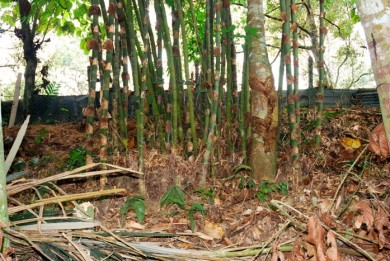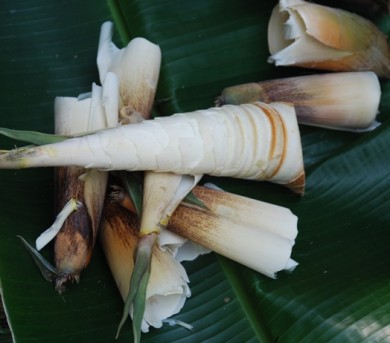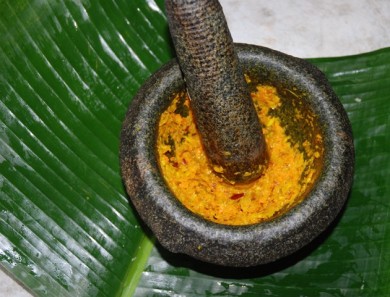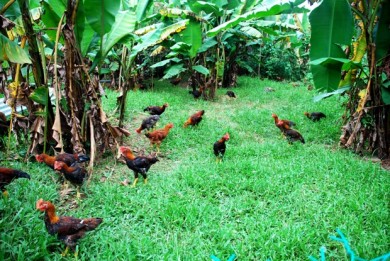Sep 14, 2011
The Earth Provides…
At the farm, we leave many of the original plants alone. And as you walk, you will find food almost everywhere – bamboos, banana piths, banana hearts and more.
Here's a clump of bamboo in our farm, which we can see growing wild alongside highways, in secondary forests, along village trails:
Here's some shoots we cut off from just such a clump.
Remove the outer bark and cut into thin slices.
Soak overnight, then replace the water with new water and bring to a boil. These steps will reduce or eliminate the bitter taste of the shoots.
Throw away the water and it is ready for making a gourmet dish.
Here are the main ingredients –
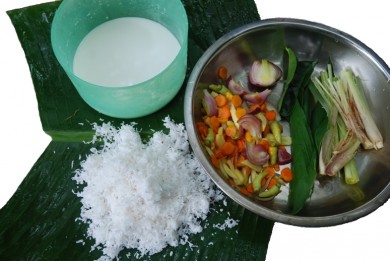
Turmeric, small onions (shallots), garlic, chillies, pound them together.
Make coconut milk from grated coconut meat.
Add serai (lemongrass), turmeric leaves and limau purut (kaffir lime) leaves and the pounded ingredients.
Put all the ingredients in the milk together and bring to a boil. Then add the bamboo shoot slices and prawns, salt and traditionally, some sugar, to taste.
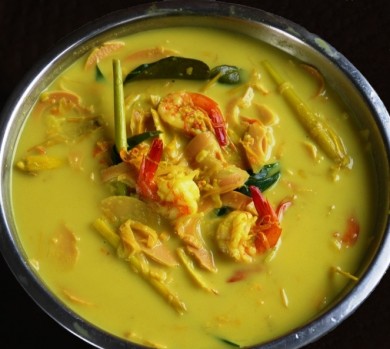
Seriously yummy; the crunchiness of the shoots offset the tender prawns to make a delicious texture-filled, aromatic dish.
18:11 Posted in Blog, Permaculture, Slow Food / Rare Receipes | Permalink | Comments (0) | Tags: rebung masak lemak, bamboo shoots, slow food
Sep 10, 2011
Lynas - What's It All About?
We are in Pahang, so we should be concerned.
Below we pasted an article lifted from http://www.loyarburok.com.
You should click the link below to read the comments as they provide views opposed to that of the writer:
http://www.loyarburok.com/2011/09/06/understanding-lynas-rare-earth-plant-13-questions/
Then you make up your own mind.
Understanding the Lynas Rare Earth plant in 13 questions
6 September 2011 | Green-World | Posted by Tan Sze Ming
I’m just a layman, I read the paper I saw the news, but I want to know more…
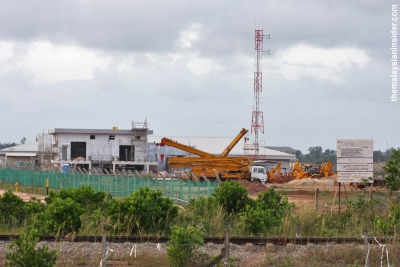
Q1: What is rare earth (RE)?
Rare earth (RE) is just a metal, as ordinary as other metals like iron, silver and gold. The difference between them is we don’t encounter RE in daily life, e.g. you don’t wear RE bracelets, you don’t build the bridge with RE. It’s precious, valuable and essential for many high-tech industries.
Q2: Who is LYNAS?
LYNAS is the owner of the RE mine and Gebeng plant, incorporated and listed in Australia. LYNAS (M) Sdn. Bhd is wholly owned by LYNAS Inc.
Q3: Where does the RE come from? What is it like?
Like other metals, RE is found in ore (rock) in West Australia. The ore is mined, cleaned and crushed into sand or powder form, before being shipped to Kuantan. The journey is about 5000 km. The size of a single grain of powder can be 100 times smaller than the diameter of a strand of hair.
Q4: Why do they take the RE from Australia and process it here?
The official statement said that Australia cannot provide high-skilled manpower, and that Australia cannot supply enough water, acids and natural gas to process RE.
Q5: What do we get in terms of income?
Malaysia offered 12 years tax break to LYNAS, which means they do not pay us anything during the first 12 years of operation. Eventually, all revenue generated here will probably be channeled back to the LYNAS Inc. share holders in Australia, and not to LYNAS (M) Sdn. Bhd.
Q6: What do we get in terms of job opportunities?
Only a total of 350 employees are needed, including expatriate, skilled and unskilled workers. The number of employees in a mid-size supermarket is greater than this.
Q7: What do we get in terms of new world-class technology?
Malaysia is not a traditional, major RE-producing county. Transferring RE processing knowledge to Malaysia does not benefit the country and its people considerably.
Q8: So, what actually do we get?
Save the “jobs created, new technology and sales revenue of chemicals, water and natural gas”, strictly speaking, in the first 12 years – nothing! Except large quantities of waste. To be more precise, 500 cubic meters/hour of waste water, 100,000 cubic meters/hour of waste gas and 280,000 tonnes/year of solid waste.
Q9: Is RE dangerous?
Most RE metals are harmless, but in natural ore RE is normally mixed with the radioactive substances. During the separation process, valuable RE is extracted and exported to US, Europe and Japan, leaving behind harmful substances in Kuantan.
Q10: How dangerous is it?
The radioactive substances release radiation and two major toxic materials – radon gas and lead. Radon is a colorless, odorless toxic gas. When it gets into the human body through inhalation, it can damage cells and cause cancer. As for lead, many years ago petrol gas been changed from leaded to unleaded, as we didn’t want lead to be released to the air through our car exhaust. Lead can harm the nervous system, and cause brain and blood diseases. In short, two key hazards can be found in Gebeng RE plant – the radiation and the toxic materials.
Q11: Where and when can the radiation, radon and lead be found?
The RE raw material (in powder or sand form) arrives at the Kuantan port, then gets transported to Gebeng by truck, where it is unloaded, transferred and processed. Waste gas from chimneys, the waste water disposed into the Balok River, the solid wastes that are stored in Gebeng – possibly in all of the above we can find the radioactive substances, which can emit radiation, radon and lead, wherever and whenever they are present.
Q12: Mr. A lives in Balok, 3km from Gebeng. Mr. B lives in Kuantan, 30km from Gebeng. Mr. C lives in KL, 300km from Gebeng. Can the radioactive materials endanger them?
In short, the answer is NO for all of them if they stay more than 100 metres away from radioactive materials. But, the answer is YES for all three if they consumed these harmful substances, even if they stay hundreds of kilometres away. WHY? The radiation emitted in Gebeng doesn’t travel long distance to harm us, hence if you stand a short distance away from the materials without consuming it, all you will get is a slight radiation. Radon gas and lead in general do not affect our body externally, as we are protected by our skin. However, if these radioactive materials contaminate the solid waste, waste water and waste gas, they will be released to the atmosphere, water streams and eventually the food chain. Once the radioactive materials enter the human body via inhalation, ingestion and wound penetration, the radiation, radon and lead will be released inside the body and these can cause very serious consequences.
Q13: Why did they say that it is safe? Why did they say that the radioactivity is low? Who should I listen to?
You decide who you should listen to! It’s your life, it’s your family, it’s your home. See above to understand why they said the radioactivity is low. The media, authorities and LYNAS have failed to report the consequences of consuming radioactive materials.
The questions were answered by Dr. Lee Chee Hong, Chemical Engineering Expert on Metals.
Here's a Chinese news report of some experts called by the Chinese business community in Pahang to brief the residents on the safety of Rare Earth processing.
11:14 Posted in Blog | Permalink | Comments (0) | Tags: lynas, rare earth plant pahang
Grass Fed Chickens - Some Basic Considerations
Choosing the right breed is important.
In the West, Cornish Crosses ( white feathered broilers) are free-ranged and pastured (grass fed).
In Malaysia, that's not possible. They will die from heat-stroke.
Many in Malaysia choose the Kabir ( a Sasso-type chicken) to free-range. Like the Cornish Crosses, the Kabir too, have very high metabolic rates and they will easily succumb to our mid-day sun without adequate shade and drinking water that is cooler than ambient.
Also, with their high metabolic rates, they need continuous feeding of high calorie feed. This defeats the purpose of pasturing as they will just sit around eating the feed pellets rather than forage. The omega 6: omega 3 ratio will be high, as they eat mainly the grain-based pellets. Health-wise to the consumer, it makes no difference whether these chickens are raised in a house or free-ranged. They will not and cannot be successfully grass fed. True grass fed chickens can never reach 2.5kg and above in weight. To grow to that size, they need a high calorie feed from grains and fats, which grasses cannot provide ( chickens are not cows and goats and cannot absorb the nutrients in grasses adequately like ruminants can).
Our tests have shown that Cornish Crosses and Kabir (Sasso) will have omega 6: omega 3 ratios as high as 40:1 and above if fed corn-based pellets ad-libitum even though raised on grass fields.
At our farm, we use mainly crosses from our traditional ayam kampung.
Ayam kampung will range whereas Cornish Crosses and Kabir will sit around
Providing sufficient space for the chickens to roam and for the land to recover fast is crucial. Our experience shows that we need a minimum of 25 sq ft of free roaming land for each chicken (factory farms provide 0.75 sq ft per chicken). Depending on the local conditions, this requirement may go up to as high as 50 sq ft of land per chicken. With sufficient space, the grasses can recover during the time the chickens are in the fields as we move them from one end of the field to the other.
So, two factors are involved here. One is the chickens must be moved along, and two the local soil conditions must allow the grasses to recover within the time that the chickens are in the field. In Malaysia we are lucky that our fields are easily 20 times more productive in terms of grass growth than many Western countries. The soil at our farm can count up to 60 to 100 earthworms per cubic feet. That's something Western farmers will die for!
Here are short clips taken from our hand phone. Note that the chickens are already market size and yet the fields are still green. In many farms when the chickens are at market size, the fields will be bare and smelly - that's perhaps one of the tests you as consumers can use to determine whether the chickens are truly grassfed.
Note how well these chickens make use of the space given to them by foraging and eating the grasses and plants.
10:13 Posted in Blog, Chickens | Permalink | Comments (0) | Tags: grass fed chicken, pastured chicken, free-range chicken, organic chicken, omega 6: omega 3 ratio, omega 3, dha, ayam kampung, cornish crosses, kabir, sasso








